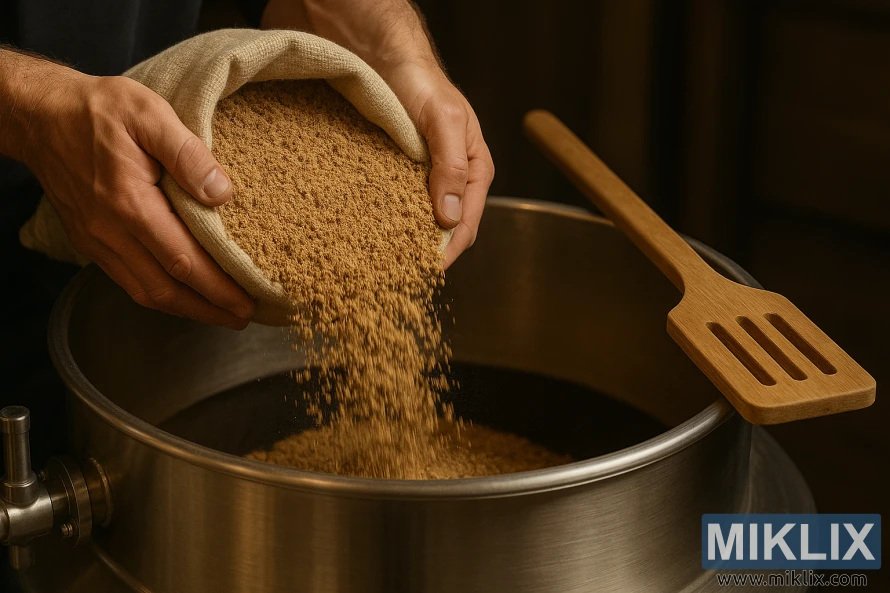Image: Pouring pale ale malt into kettle
Published: July 21, 2025 at 2:55:14 PM UTC
Last updated: September 27, 2025 at 3:26:08 PM UTC
Close-up of a brewer pouring freshly milled pale ale malt into a stainless kettle with a mash paddle nearby, highlighting craftsmanship and brewing detail.
In the quiet hum of a working brewhouse, a moment of tactile precision unfolds as a brewer pours freshly milled pale ale malt into a gleaming stainless steel kettle. The grains cascade from a cloth sack in a golden stream, catching the soft, ambient light that filters through the space. Each kernel, warm in hue and slightly textured, reflects the care taken in its selection and preparation. The malt glows with a subtle radiance, its color reminiscent of sunlit straw and toasted biscuit, hinting at the flavors it will soon impart. The brewer’s hands, steady and deliberate, guide the flow with practiced ease, revealing a deep familiarity with the rhythm and requirements of the brewing process.
The kettle itself is polished to a mirror-like finish, its curved surface reflecting the surrounding environment in muted tones. A wooden mash paddle rests across its rim, its slotted head worn smooth from repeated use. This simple tool, carved from sturdy timber, stands as a quiet symbol of tradition amidst the modernity of stainless steel and precision valves. It will soon be used to stir the mash, ensuring even hydration and temperature distribution as the grains steep in hot water. The paddle’s presence suggests the next step in the process—mashing—where enzymes will activate and convert starches into fermentable sugars, laying the foundation for the beer’s body and alcohol content.
The lighting in the room is soft and diffused, casting gentle shadows that enhance the textures of the malt and the contours of the kettle. It creates an atmosphere of calm focus, where every movement feels intentional and every detail matters. The brewer’s posture, slightly leaned forward, conveys attentiveness and care, as if listening to the grains as they fall, gauging their weight and flow. There is no rush here, only the quiet satisfaction of a craft well-practiced. The air is filled with the earthy aroma of crushed barley, a scent that evokes fields, harvests, and the promise of fermentation.
This scene is more than a technical step in beer production—it is a portrait of craftsmanship. The act of pouring malt is imbued with meaning, connecting the brewer to centuries of tradition and to the countless variables that shape the final product. The choice of pale ale malt, with its balanced profile and subtle sweetness, reflects a desire to create a beer that is approachable yet nuanced, one that showcases malt character without overpowering the palate. It is a foundational ingredient, versatile and expressive, capable of supporting a wide range of hop profiles and yeast strains.
In this moment, the brewer is both artist and technician, blending intuition with knowledge to begin the transformation of grain into beer. The scene captures the essence of brewing as a sensory and intellectual pursuit, where the smallest actions contribute to the complexity of flavor and the integrity of the final pour. It is a celebration of process, of patience, and of the quiet joy found in the details. From the golden grains to the waiting kettle, every element speaks to the care and passion that define the craft of brewing.
The image is related to: Brewing Beer with Pale Ale Malt

